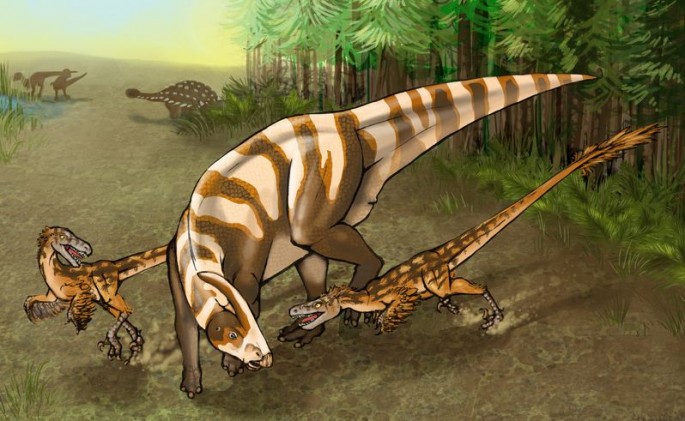The unusually large olfactory bulb of a newly discovered small dromaeosaur (otherwise known as a raptor) likely means this predator had a powerful sense of smell that made it a more vicious killer than Velociraptor.
The newly named dinosaur called "Saurornitholestes sullivani" was identified by Steven Jasinski, a doctoral student in the School of Arts & Sciences' Department of Earth and Environmental Science at the University of Pennsylvania. S. sullivani is a species of dinosaur closely related to Velociraptor that gained worldwide notoriety in the movie, Jurassic Park.
Jasinski discovered the new species while investigating a specimen originally assigned to a previously known species. His analysis, however, suggested the fossil (part of the dinosaur's skull) represented a brand new species.
S. sullivani was a small dinosaur. It was less than three feet at the hip and six feet in length. Jasinski said this raptor would likely have been quick and agile. It might have also hunted in packs, making it a deadlier hunter.
"Although it was not large, this was not a dinosaur you would want to mess with," Jasinski said
The fossil, which was some 75 million years old, was discovered by paleontologist Robert Sullivan in the Bisti/De-Na-Zin Wilderness Area of New Mexico in 1999. Scientists initially believed it was a member of Saurornitholestes langstoni, a species of theropod dinosaurs in the Dromaeosauridae family found in present-day Alberta, Canada.
Jasinski, however, observed that the surface of the skull corresponding with the brain's olfactory bulb was unusually large. This finding implies a powerful sense of smell.
"This feature means that Saurornitholestes sullivani had a relatively better sense of smell than other dromaeosaurid dinosaurs, including Velociraptor, Dromaeosaurus, and Bambiraptor," Jasinski said. "This keen olfaction may have made S. sullivani an intimidating predator, as well."
S. sullivani comes from the end of the time of dinosaurs, or the Late Cretaceous. It represents the only named dromaeosaur from this period in North America south of Montana.
S. sullivani shared its world with numerous other dinosaurs. Other contemporary meat-eating theropods included the tyrannosaurs Bistahieversor sealeyi and Daspletosaurus, along with ostrich-like ornithomimids.
Plant-eating contemporary dinosaurs included the duck-billed hadrosaurs Parasaurolophus tubicen and Kritosaurus navajovius; the horned dinosaur Pentaceratops sternbergii and the pachycephalsaurs Stegoceras novomexicanum.
At the time S. sullivani lived, North America was split into two continents separated by an inland sea. This dinosaur lived on the western shores in an area called Laramidia.
Numerous dromaeosaurs are known from more northern areas in Laramidia, including Alberta and Montana. S. sullivani represents the only named dromaeosaur from the Late Cretaceous of southern Laramidia.
Jasinski reported his findings this month in the New Mexico Museum of Natural History and Science Bulletin.



























